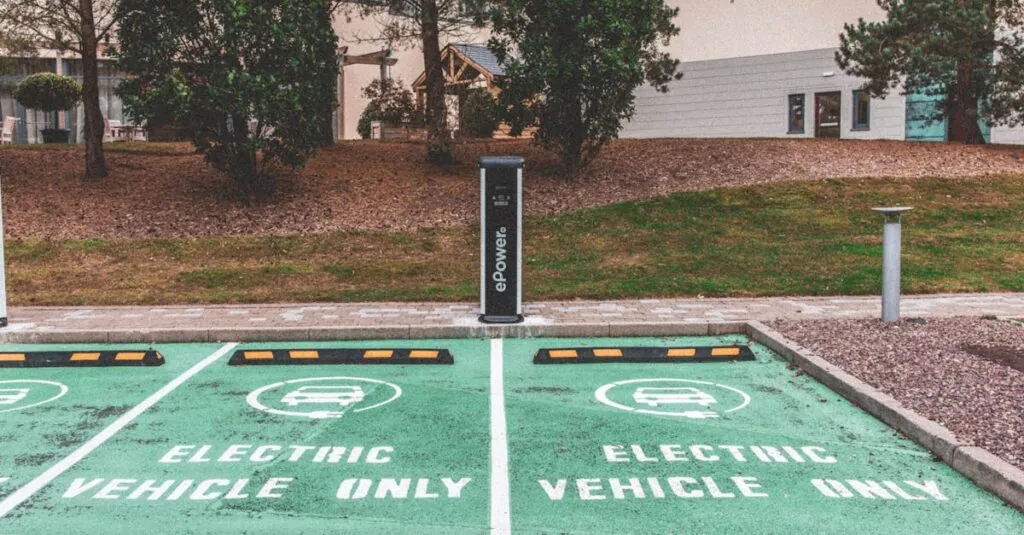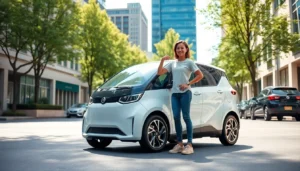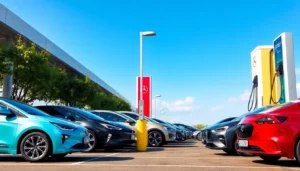In a world where traffic jams seem to have their own social lives and gas prices are climbing faster than a cat on a hot tin roof, e-mobility is here to save the day. Imagine gliding silently past honking cars while your electric ride sips power instead of guzzling gas. It’s not just a trend; it’s a revolution on wheels, and it’s about time everyone hopped on board.
Overview of E-Mobility
E-mobility encompasses the integration of electric vehicles and charging infrastructure into transportation ecosystems. This movement emphasizes the environmental advantages of electric vehicles compared to traditional gas-powered ones. Electric vehicles produce zero tailpipe emissions, contributing to improved urban air quality. Long-term savings occur due to lower operating costs associated with electricity instead of gasoline.
As more consumers adopt electric vehicles, manufacturers respond by expanding their offerings. Numerous brands now provide a range of models, from compact cars to SUVs and trucks. Advancements in battery technology have increased the driving range of electric vehicles, making them more viable for daily use. Charging networks continue to grow, providing more locations for consumers to recharge their vehicles conveniently.
Government policies support e-mobility initiatives, offering incentives for electric vehicle purchase and infrastructure development. Many cities implement electric vehicle adoption strategies to decrease their carbon footprints and energy dependencies. Research shows that nearly 30% of new car sales could be electric by 2030 in regions focused on sustainability.
E-mobility not only focuses on personal vehicles but also includes electric bikes and scooters, promoting alternative transportation methods. Public transportation systems increasingly adopt electric buses, reducing emissions and enhancing service efficiency. This shift strengthens the move towards smart city designs that prioritize sustainable transport solutions.
Innovative solutions, such as shared mobility services, align with the principles of e-mobility. Ride-sharing companies offer electric vehicle options, decreasing the number of gas-powered cars on the road. E-mobility represents a transformative approach to transportation, reshaping how people commute and interact with their environment.
Benefits of E-Mobility
E-mobility offers numerous advantages, particularly in environmental and economic aspects.
Environmental Impact
Electric vehicles produce zero tailpipe emissions, significantly improving urban air quality. Improved air quality directly contributes to better public health outcomes. Usage of renewable energy sources for charging can further reduce carbon footprints. Enhanced battery technology minimizes resource extraction impacts. E-mobility supports sustainable living by promoting cleaner alternatives to traditional transportation. Adoption of electric bikes and scooters encourages eco-friendly commuting options. Cities that integrate electric public transport see decreased overall emissions, promoting greener urban planning.
Economic Advantages
E-mobility reduces fuel costs for users due to lower electricity prices compared to gasoline. Savings on maintenance expenses occur since electric vehicles typically require less upkeep than conventional vehicles. Growth in the electric vehicle market stimulates job creation in manufacturing and infrastructure sectors. Incentives such as tax breaks for electric vehicle purchases provide financial relief for consumers. Investing in e-mobility infrastructure attracts funding for local economies. Increased availability of electric charging stations enhances real estate values. Overall, e-mobility fosters economic resilience and innovation in transportation.
Types of E-Mobility Solutions
E-mobility features various solutions that enhance urban transportation and environmental sustainability. These innovations improve access and reduce dependency on fossil fuels.
Electric Vehicles
Electric vehicles (EVs) include cars, trucks, and vans powered entirely by electricity. They operate using rechargeable batteries and deliver zero tailpipe emissions, significantly benefiting urban air quality. With advancements in battery technology, many EV models now offer ranges exceeding 300 miles per charge. The growing availability of charging infrastructure enables convenient recharging at home and on the road, increasing consumer confidence in electric transportation. Furthermore, manufacturers invest in developing diverse EV options, catering to various preferences and needs, making electric driving more accessible and mainstream.
E-Bikes and E-Scooters
E-bikes and e-scooters represent popular alternatives for short-distance travel. Equipped with electric motors, e-bikes enhance pedaling efforts, making cycling more accessible for wider audiences. Many urban areas now implement e-bike sharing programs, promoting sustainable commuting. In addition, e-scooters offer a compact and agile solution for navigating city streets. These vehicles are particularly advantageous in reducing traffic congestion and lowering emissions since they require less road space compared to traditional cars. As cities focus on boosting micro-mobility options, e-bikes and e-scooters continue to grow in adoption, reshaping how people approach local transportation.
Key Players in the E-Mobility Market
E-mobility features a diverse landscape of major manufacturers and innovative startups driving growth and technology in the industry.
Major Manufacturers
Leading automotive manufacturers play a crucial role in the e-mobility market. Companies like Tesla and Nissan set benchmarks with electric vehicle designs, reliability, and performance. Volkswagen actively pursues electrification, launching the ID. series to cater to diverse consumer needs. Toyota, known for its hybridity, promotes hydrogen fuel cell technology alongside electric vehicles, expanding the sustainability repertoire. General Motors emphasizes their all-electric future, showcasing models like the Chevrolet Bolt EV, highlighting an increased commitment to eco-friendly alternatives.
Innovative Startups
Innovative startups reshape the e-mobility landscape by introducing fresh ideas and technology. Companies such as Rivian and Lucid Motors capture attention with electric trucks and luxury vehicles, appealing to niche markets. Nuro focuses on autonomous delivery solutions, improving logistics through electric vehicles. E-scooter companies like Bird and Lime revolutionize urban transportation by providing accessible micro-mobility solutions. Several of these startups prioritize sustainability and technology, ensuring they address modern transportation challenges while complementing established manufacturers’ efforts.
Challenges Facing E-Mobility
E-mobility, while promising, faces several substantial challenges that hinder its broader adoption.
Infrastructure Development
Infrastructure development remains critical for supporting e-mobility’s growth. An extensive charging network must match the increasing number of electric vehicles on the road. Currently, a lack of charging stations in urban and rural areas limits access for users. Building additional stations requires significant investment from both public and private sectors, making collaboration essential. Innovations in fast-charging technologies can improve availability and convenience, yet deployment remains slow. Strategic planning for infrastructure expansion is necessary to cater to rising demand and ensure users can reliably recharge their electric vehicles.
Regulatory Hurdles
Regulatory hurdles present further obstacles to the expansion of e-mobility. Government policies often vary by region, leading to confusion for consumers and manufacturers alike. Incentives for electric vehicle purchases might not be uniform, creating disparities in adoption rates. Additionally, environmental regulations can impose limitations on battery manufacturing and recycling processes, complicating production. Addressing these issues requires cooperation among governments, manufacturers, and environmental agencies to establish clear regulations that support sustainable growth. Effective frameworks can help streamline e-mobility initiatives and promote a more consistent approach across regions.
E-mobility is more than just a trend; it’s a vital shift in how society approaches transportation. As electric vehicles and alternative mobility solutions gain traction, they promise to create cleaner urban environments and boost economic growth. The advancements in battery technology and the expansion of charging infrastructure are paving the way for broader adoption.
While challenges remain, the commitment from manufacturers, governments, and consumers is driving the e-mobility movement forward. By embracing these innovations, communities can enjoy improved air quality, reduced emissions, and enhanced mobility options. The future of transportation is electric, and the journey toward sustainable urban living is just beginning.





